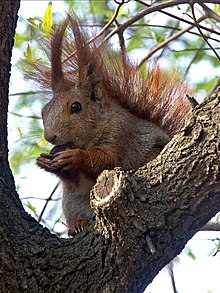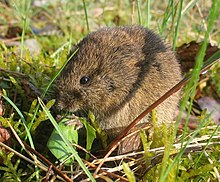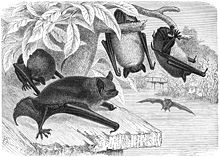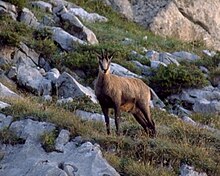List of mammals of Metropolitan France
This list shows the IUCN Red List status of the 120 mammal species occurring in Metropolitan France. One of them is critically endangered, two are endangered, thirteen are vulnerable, and four are near threatened. One of the species listed for France is considered to be extinct.
The following tags are used to highlight each species' conservation status as assessed on the respective IUCN Red Lists published by the International Union for Conservation of Nature:
| EX | Extinct | No reasonable doubt that the last individual has died. |
| EW | Extinct in the wild | Known only to survive in captivity or as a naturalized populations well outside its previous range. |
| CR | Critically endangered | The species is in imminent risk of extinction in the wild. |
| EN | Endangered | The species is facing an extremely high risk of extinction in the wild. |
| VU | Vulnerable | The species is facing a high risk of extinction in the wild. |
| NT | Near threatened | The species does not meet any of the criteria that would categorise it as risking extinction but it is likely to do so in the future. |
| LC | Least concern | There are no current identifiable risks to the species. |
| DD | Data deficient | There is inadequate information to make an assessment of the risks to this species. |
Subclass: Theria
Infraclass: Eutheria
Order: Rodentia (rodents)







Rodents make up the largest order of mammals, with over 40% of mammalian species. They have two incisors in the upper and lower jaw which grow continually and must be kept short by gnawing. Most rodents are small though the capybara can weigh up to 45 kg (99 lb).
- Suborder: Sciurognathi
- Family: Castoridae (beavers)
- Genus: Castor
- Eurasian beaver, C. fiber LC[1]
- Genus: Castor
- Family: Sciuridae (squirrels)
- Subfamily: Sciurinae
- Genus: Sciurus
- Red squirrel, S. vulgaris LC[2]
- Genus: Sciurus
- Subfamily: Xerinae
- Genus: Marmota
- Alpine marmot, Marmota marmota LC
- Genus: Marmota
- Subfamily: Sciurinae
- Family: Gliridae (dormice)
- Subfamily: Leithiinae
- Genus: Eliomys
- Garden dormouse, E. quercinus NT[3]
- Genus: Muscardinus
- Hazel dormouse, Muscardinus avellanarius LC
- Genus: Eliomys
- Subfamily: Glirinae
- Genus: Glis
- Edible dormouse, Glis glis LC
- Genus: Glis
- Subfamily: Leithiinae
- Family: Cricetidae
- Subfamily: Cricetinae
- Genus: Cricetus
- European hamster, Cricetus cricetus LC
- Genus: Cricetus
- Subfamily: Arvicolinae
- Genus: Arvicola
- Southwestern water vole, A. sapidus VU[4]
- European water vole, A. amphibius LC[5]
- Genus: Chionomys
- Snow vole, Chionomys nivalis LC
- Genus: Clethrionomys
- Bank vole, Clethrionomys glareolus LC
- Genus: Microtus
- Field vole, Microtus agrestis LC
- Common vole, Microtus arvalis LC
- Cabrera's vole, Microtus cabrerae LC
- Mediterranean pine vole, Microtus duodecimcostatus LC
- Gerbe's vole, Microtus gerbei LC
- Lusitanian pine vole, Microtus lusitanicus LC
- Alpine pine vole, Microtus multiplex LC
- Savi's pine vole, Microtus savii LC
- European pine vole, Microtus subterraneus LC
- Genus: Arvicola
- Subfamily: Cricetinae
- Family: Muridae (mice, rats, voles, gerbils, hamsters, etc.)
- Subfamily: Murinae
- Genus: Apodemus
- Alpine field mouse, Apodemus alpicola
- Yellow-necked mouse, Apodemus flavicollis LC
- Wood mouse, Apodemus sylvaticus LC
- Genus: Micromys
- Eurasian harvest mouse, Micromys minutus LC
- Genus: Mus
- Algerian mouse, Mus spretus LC
- Genus: Apodemus
- Subfamily: Murinae
- Family: Castoridae (beavers)
Order: Lagomorpha (lagomorphs)

The lagomorphs comprise two families, Leporidae (hares and rabbits), and Ochotonidae (pikas). Though they can resemble rodents, and were classified as a superfamily in that order until the early 20th century, they have since been considered a separate order. They differ from rodents in a number of physical characteristics, such as having four incisors in the upper jaw rather than two.
- Family: Leporidae (rabbits, hares)
- Genus: Oryctolagus
- European rabbit, O. cuniculus EN[6]
- Genus: Lepus
- European hare, L. europaeus LC[7]
- Mountain hare, L. timidus LC
- Genus: Oryctolagus
- Family: Prolagidae
- Genus: Prolagus
- Sardinian pika, P. sardus EX
- Genus: Prolagus
Order: Erinaceomorpha (hedgehogs and gymnures)

The order Erinaceomorpha contains a single family, Erinaceidae, which comprise the hedgehogs and gymnures. The hedgehogs are easily recognised by their spines while gymnures look more like large rats.
- Family: Erinaceidae (hedgehogs)
- Subfamily: Erinaceinae
- Genus: Erinaceus
- West European hedgehog, E. europaeus LC[8]
- Genus: Atelerix
- North African hedgehog, A. algirus LC
- Genus: Erinaceus
- Subfamily: Erinaceinae
Order: Soricomorpha (shrews, moles, and solenodons)


The "shrew-forms" are insectivorous mammals. Shrews and solenodons closely resemble mice, while moles are stout-bodied burrowers.
- Family: Soricidae (shrews)
- Subfamily: Crocidurinae
- Genus: Crocidura
- Bicolored shrew, Crocidura leucodon LC
- Greater white-toothed shrew, Crocidura russula LC
- Lesser white-toothed shrew, Crocidura suaveolens LC
- Genus: Suncus
- Etruscan shrew, Suncus etruscus LC
- Genus: Crocidura
- Subfamily: Soricinae
- Tribe: Nectogalini
- Genus: Neomys
- Southern water shrew, Neomys anomalus LC
- Eurasian water shrew, Neomys fodiens LC
- Genus: Neomys
- Tribe: Soricini
- Genus: Sorex
- Alpine shrew, Sorex alpinus LC
- Common shrew, Sorex araneus LC
- Crowned shrew, Sorex coronatus LC
- Eurasian pygmy shrew, Sorex minutus LC
- Genus: Sorex
- Tribe: Nectogalini
- Subfamily: Crocidurinae
- Family: Talpidae (moles)
- Subfamily: Talpinae
- Tribe: Desmanini
- Genus: Galemys
- Pyrenean desman, G. pyrenaicus VU[9]
- Genus: Galemys
- Tribe: Talpini
- Genus: Talpa
- Mediterranean mole, T. caeca LC
- European mole, T. europaea LC
- Roman mole, T. romana LC
- Genus: Talpa
- Tribe: Desmanini
- Subfamily: Talpinae
Order: Chiroptera (bats)





The bats' most distinguishing feature is that their forelimbs are developed as wings, making them the only mammals capable of flight. Bat species account for about 20% of all mammals.
- Family: Vespertilionidae
- Subfamily: Myotinae
- Genus: Myotis
- Bechstein's bat, M. bechsteini NT[10]
- Pond bat, M. dasycneme NT[11]
- Lesser mouse-eared bat, M. blythii LC
- Brandt's bat, M. brandti LC
- Long-fingered bat, M. capaccinii VU
- Daubenton's bat, M. daubentonii LC
- Geoffroy's bat, M. emarginatus VU
- Greater mouse-eared bat, M. myotis LC
- Whiskered bat, M. mystacinus LC
- Natterer's bat, M. nattereri LC
- Cryptic myotis, M. crypticus NE
- Escalera's bat, M. escalerai NE
- Genus: Myotis
- Subfamily: Vespertilioninae
- Genus: Barbastella
- Barbastelle, B. barbastellus VU
- Genus: Eptesicus
- Northern bat, E. nilssoni LC
- Serotine bat, E. serotinus LC
- Genus: Hypsugo
- Savi's pipistrelle, H. savii LC[12]
- Genus: Nyctalus
- Greater noctule bat, N. lasiopterus NT[13]
- Lesser noctule, N. leisleri NT
- Common noctule, N. noctula LC
- Genus: Pipistrellus
- Nathusius' pipistrelle, P. nathusii LC[14]
- Kuhl's pipistrelle, P. kuhlii LC
- Common pipistrelle, P. pipistrellus LC
- Genus: Plecotus
- Brown long-eared bat, P. auritus LC
- Grey long-eared bat, P. austriacus LC
- Genus: Vespertilio
- Parti-coloured bat, V. murinus LC
- Genus: Barbastella
- Subfamily: Miniopterinae
- Genus: Miniopterus
- Schreibers' long-fingered bat, M. schreibersii LC
- Genus: Miniopterus
- Subfamily: Myotinae
- Family: Molossidae
- Genus: Tadarida
- European free-tailed bat, T. teniotis LC
- Genus: Tadarida
- Family: Rhinolophidae
- Subfamily: Rhinolophinae
- Genus: Rhinolophus
- Mediterranean horseshoe bat, R. euryale VU
- Greater horseshoe bat, R. ferrumequinum NT
- Lesser horseshoe bat, R. hipposideros LC
- Mehely's horseshoe bat, R. mehelyi VU
- Genus: Rhinolophus
- Subfamily: Rhinolophinae
Order: Cetacea (whales)





The order Cetacea includes whales, dolphins and porpoises. They are the mammals most fully adapted to aquatic life with a spindle-shaped nearly hairless body, protected by a thick layer of blubber, and forelimbs and tail modified to provide propulsion underwater.
- Suborder: Mysticeti
- Family: Balaenidae (right whales)
- Genus: Balaena
- Bowhead whale, Balaena mysticetus LC vagrant[15][16][17]
- Genus: Eubalaena
- North Atlantic right whale, Eubalaena glacialis CR or functionally extinct in European waters
- Genus: Balaena
- Family: Eschrichtiidae (grey whales)
- Genus: Eschrichtius
- North Atlantic grey whale, Eschrichtius robustus EX[18][19][20])
- Genus: Eschrichtius
- Family: Balaenopteridae (rorquals)
- Subfamily: Megapterinae
- Genus: Megaptera
- Humpback whale, Megaptera novaeangliae VU
- Genus: Megaptera
- Subfamily: Balaenopterinae
- Genus: Balaenoptera
- Fin whale, Balaenoptera physalus EN
- Minke whale, Balaenoptera acutorostrata NT
- Genus: Balaenoptera
- Subfamily: Megapterinae
- Family: Balaenidae (right whales)
- Suborder: Odontoceti
- Family: Kogiidae
- Genus: Kogia
- Pygmy sperm whale, Kogia breviceps LC
- Genus: Kogia
- Family: Ziphidae (beaked whales)
- Genus: Ziphius
- Cuvier's beaked whale, Ziphius cavirostris DD
- Subfamily: Hyperoodontidae
- Genus: Hyperoodon
- Northern bottlenose whale, Hyperoodon ampullatus DD
- Genus: Mesoplodon
- Sowerby's beaked whale, Mesoplodon bidens DD
- True's beaked whale, Mesoplodon mirus DD
- Genus: Hyperoodon
- Genus: Ziphius
- Family: Phocoenidae (porpoises)
- Genus: Phocoena
- Harbour porpoise, Phocoena phocoena VU
- Genus: Phocoena
- Family: Delphinidae (marine dolphins)
- Genus: Steno
- Rough-toothed dolphin, Steno bredanensis DD
- Genus: Tursiops
- Bottlenose dolphin, Tursiops truncatus DD
- Genus: Stenella
- Striped dolphin, Stenella coeruleoalba LC
- Genus: Delphinus
- Short-beaked common dolphin, Delphinus delphis LC
- Genus: Lagenorhynchus
- Atlantic white-sided dolphin, Lagenorhynchus acutus LC
- White-beaked dolphin, Lagenorhynchus albirostris LC
- Genus: Grampus
- Risso's dolphin, Grampus griseus DD
- Genus: Feresa
- Pygmy killer whale, Feresa attenuata DD
- Genus: Pseudorca
- False killer whale, Pseudorca crassidens LC
- Genus: Globicephala
- Pilot whale, Globicephala melas LC
- Genus: Orcinus
- Genus: Steno
- Superfamily: Platanistoidea
- Family: Monodontidae
- Genus: Delphinapterus
- Beluga, Delphinapterus leucas VU
- Genus: Delphinapterus
- Family: Monodontidae
- Family: Kogiidae
Order: Carnivora (carnivorans)




There are over 260 species of carnivorans, the majority of which feed primarily on meat. They have a characteristic skull shape and dentition.
- Suborder: Feliformia
- Family: Felidae (cats)
- Subfamily: Felinae
- Genus: Felis
- European wildcat, F. silvestris LC
- Genus: Lynx
- Eurasian lynx, L. lynx LC[22]
- Genus: Felis
- Subfamily: Felinae
- Family: Viverridae (civets, mongooses, etc.)
- Subfamily: Viverrinae
- Genus: Genetta
- Common genet, G. genetta LC[23]
- Genus: Genetta
- Subfamily: Viverrinae
- Family: Felidae (cats)
- Suborder: Caniformia
- Family: Canidae (dogs, foxes)
- Family: Ursidae (bears)
- Genus: Ursus
- Brown bear, U. arctos LC[26]
- Genus: Ursus
- Family: Mustelidae (mustelids)
- Genus: Mustela
- Stoat, Mustela erminea LC
- European mink, Mustela lutreola EN
- Least weasel, Mustela nivalis LC
- European polecat, Mustela putorius LC
- Genus: Martes
- Beech marten, Martes foina LC
- Pine marten, Martes martes LC
- Genus: Meles
- Eurasian badger, M. meles LC[27]
- Genus: Lutra
- European otter, L. lutra NT[28]
- Genus: Mustela
- Family: Odobenidae
- Family: Phocidae (earless seals)
- Genus: Erignathus
- Bearded seal, Erignathus barbatus LC
- Genus: Halichoerus
- Grey seal, Halichoerus grypus LC
- Genus: Monachus
- Mediterranean monk seal, M. monachus EN (globally)[29]
- Genus: Phoca
- Common seal, Phoca vitulina LR/lc
- Genus: Erignathus
Order: Artiodactyla (even-toed ungulates)

The even-toed ungulates are ungulates whose weight is borne about equally by the third and fourth toes, rather than mostly or entirely by the third as in perissodactyls. There are about 220 artiodactyl species, including many that are of great economic importance to humans.
- Family: Suidae (pigs)
- Family: Cervidae (deer)
- Subfamily: Cervinae
- Genus: Cervus
- Red deer, Cervus elaphus LC
- Genus: Dama
- Fallow deer, Dama dama LC
- Genus: Cervus
- Subfamily: Capreolinae
- Subfamily: Cervinae
- Family: Bovidae (cattle, antelope, sheep, goats)
- Subfamily: Caprinae
- Genus: Capra
- Alpine ibex, Capra ibex LC
- Genus: Rupicapra
- Pyrenean chamois, Rupicapra pyrenaica LC
- Chamois, Rupicapra rupicapra LC
- Genus: Ovis
- Mouflon, Ovis orientalis VU
- Genus: Capra
- Subfamily: Caprinae
See also
- Wildlife of Metropolitan France
- List of chordate orders
- Lists of mammals by region
- List of prehistoric mammals
- Mammal classification
- List of mammals described in the 2000s
Notes
- ^ Batbold, J.; Batsaikhan, N.; Shar, S.; Hutterer, R.; Kryštufek, B.; Yigit, N.; Mitsain, G.; Palomo, L. (2016). "Castor fiber". IUCN Red List of Threatened Species. 2016: e.T4007A115067136.
- ^ Amori, G.; Hutterer, R.; Kryštufek, B.; Yigit, N.; Mitsain, G.; Muñoz, L. J. P. (2010). "Sciurus vulgaris". IUCN Red List of Threatened Species. 2010: e.T20025A9136220.
- ^ Bertolino, S.; Amori, G.; Henttonen, H.; Zagorodnyuk, I.; Zima, J.; Juškaitis, R.; Meinig, H.; Kryštufek, B. (2008). "Eliomys quercinus". IUCN Red List of Threatened Species. 2008: e.T7618A12835766. doi:10.2305/IUCN.UK.2008.RLTS.T7618A12835766.en.
{{cite journal}}: Unknown parameter|last-author-amp=ignored (|name-list-style=suggested) (help) - ^ Rigaux, P.; Vaslin, M.; Noblet, J. F.; Amori, G.; Muñoz, L. J. P. (2008). "Arvicola sapidus". IUCN Red List of Threatened Species. 2008: e.T2150A9290712.
{{cite journal}}: Unknown parameter|last-author-amp=ignored (|name-list-style=suggested) (help) - ^ Batsaikhan, N.; Henttonen, H.; Meinig, H.; Shenbrot, G., Bukhnikashvili, A., Hutterer, R., Kryštufek, B., Yigit, N., Mitsain, G. & Palomo, L. (2016). "Arvicola amphibius". IUCN Red List of Threatened Species. 2016: e.T2149A115060819. doi:10.2305/IUCN.UK.2016-3.RLTS.T2149A115060819.en.
{{cite journal}}: CS1 maint: multiple names: authors list (link) - ^ Villafuerte, R.; Delibes-Mateos, M. (2019). "Oryctolagus cuniculus". IUCN Red List of Threatened Species. 2019: e.T41291A45189779.
- ^ Hacklande, K.; Schai-Braun, S. (2019). "Lepus europaeus". IUCN Red List of Threatened Species. 2019: e.T41280A45187424. doi:10.2305/IUCN.UK.2019-1.RLTS.T41280A45187424.en.
- ^ Amori, G. (2016). "Erinaceus europaeus". IUCN Red List of Threatened Species. 2016: e.T29650A2791303. doi:10.2305/IUCN.UK.2016-3.RLTS.T29650A2791303.en.
- ^ Fernandes, M.; Herrero, J.; Aulagnier, S.; Amori, G. (2008). "Galemys pyrenaicus". IUCN Red List of Threatened Species. 2008: e.T8826A12934876.
{{cite journal}}: Unknown parameter|last-author-amp=ignored (|name-list-style=suggested) (help) - ^ Paunović, M. (2019). "Myotis bechsteinii". IUCN Red List of Threatened Species. 2019: e.T14123A22053752. doi:10.2305/IUCN.UK.2016-2.RLTS.T14123A22053752.en.
- ^ Piraccini, R. (2016). "Myotis dasycneme". IUCN Red List of Threatened Species. 2016: e.T14127A22055164. doi:10.2305/IUCN.UK.2016-2.RLTS.T14127A22055164.en.
- ^ Hutson, A. M.; Spitzenberger, F.; Juste, J.; Aulagnier, S.; Palmeirim, J.; Paunovic, M.; Karatas, A. (2010). "Hypsugo savii". IUCN Red List of Threatened Species. 2010: e.T44856A10955205.
- ^ Hutson, A. M.; Alcaldé, J. T.; Juste, J.; Karataş, A.; Palmeirim, J. & Paunović, M. (2010). "Nyctalus lasiopterus". IUCN Red List of Threatened Species. 2010: e.T14918A4471682.
{{cite journal}}: CS1 maint: multiple names: authors list (link) - ^ Hutson, A. M.; Spitzenberger, F.; Juste, J.; Aulagnier, S.; Palmeirim, J.; Karatas, A. & Paunovic, M. (2010). "Pipistrellus nathusii". IUCN Red List of Threatened Species. 2010: e.T17316A6966886.
{{cite journal}}: CS1 maint: multiple names: authors list (link) - ^ "Bénodet. Un cétacé en goguette devant la grande plage". Retrieved 5 July 2016.
- ^ "Rare arctic bowhead whale seen off Cornwall - BBC News". Retrieved 5 July 2016.
- ^ "Bénodet. Un cétacé repéré près de la plage du Trez". Retrieved 5 July 2016.
- ^ The MORSE Project - Ancient whale exploitation in the Mediterranean: species matters
- ^ Macé M. (2003). "Did the Gray Whale calve in the Mediterranean?". Lattara. 16: 153–164.
- ^ "Are grey whales climate change's big winners?". Retrieved 5 July 2016.
- ^ Reeves, R.; Pitman, R.L.; Ford, J.K.B. (2017). "Orcinus orca". IUCN Red List of Threatened Species. 2017: e.T15421A50368125. doi:10.2305/IUCN.UK.2017-3.RLTS.T15421A50368125.en.
- ^ Breitenmoser, U.; Breitenmoser-Würsten, C.; Lanz, T.; von Arx, M.; Antonevich, A.; Bao, W.; Avgan, B. (2015). "Lynx lynx". IUCN Red List of Threatened Species. 2015: e.T12519A121707666.
{{cite journal}}: Unknown parameter|last-author-amp=ignored (|name-list-style=suggested) (help) - ^ Gaubert, P.; Carvalho, F.; Camps, D.; Do Linh San, E. (2015). "Genetta genetta". IUCN Red List of Threatened Species. 2015: e.T41698A45218636. doi:10.2305/IUCN.UK.2015-4.RLTS.T41698A45218636.en.
{{cite journal}}: Unknown parameter|last-author-amp=ignored (|name-list-style=suggested) (help) - ^ Hoffmann, M.; Sillero-Zubiri, C. (2016). "Vulpes vulpes". IUCN Red List of Threatened Species. 2016: e.T23062A46190249. doi:10.2305/IUCN.UK.2016-1.RLTS.T23062A46190249.en.
- ^ Boitani, L.; Phillips, M. & Jhala, Y. (2018). "Canis lupus". IUCN Red List of Threatened Species. 2018: e.T3746A119623865. doi:10.2305/IUCN.UK.2018-2.RLTS.T3746A119623865.en.
{{cite journal}}: CS1 maint: multiple names: authors list (link) - ^ McLellan, B. N.; Proctor, M. F.; Huber, D.; Michel, S. (2017). "Ursus arctos". IUCN Red List of Threatened Species. 2017: e.T41688A121229971. doi:10.2305/IUCN.UK.2017-3.RLTS.T41688A121229971.en.
{{cite journal}}: Unknown parameter|last-author-amp=ignored (|name-list-style=suggested) (help) - ^ Kranz, A.; Abramov, A. V.; Herrero, J.; Maran, T. (2016). "Meles meles". IUCN Red List of Threatened Species. 2016: e.T29673A45203002.
{{cite journal}}: Unknown parameter|last-author-amp=ignored (|name-list-style=suggested) (help) - ^ Roos, A.; Loy, A.; de Silva, P.; Hajkova, P.; Zemanová, B. (2015). "Lutra lutra". IUCN Red List of Threatened Species. 2015: e.T12419A21935287. doi:10.2305/IUCN.UK.2015-2.RLTS.T12419A21935287.en.
- ^ Karamanlidis, A.; Dendrinos, P. (2015). "Monachus monachus". IUCN Red List of Threatened Species. 2015: e.T13653A45227543. doi:10.2305/IUCN.UK.2015-4.RLTS.T13653A45227543.en.
{{cite journal}}: Unknown parameter|last-author-amp=ignored (|name-list-style=suggested) (help)
References
- "The IUCN Red List of Threatened Species: Mammals of France". IUCN. 2001. Retrieved 22 May 2007. [dead link]
- "Mammal Species of the World". Smithsonian National Museum of Natural History. 2005. Archived from the original on 27 April 2007. Retrieved 22 May 2007.
- "Animal Diversity Web". University of Michigan Museum of Zoology. 1995–2006. Retrieved 22 May 2007.
